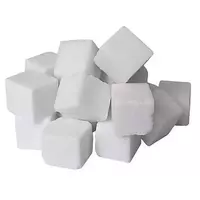Sugar

We can say with confidence that there is hardly a person in the world who has never tasted sugar. The useful properties of sugar, as well as harmful ones, by the way, are the main topics of numerous articles and scientific experiments. But until now, this everyday product for us is sheepish with an endless variety of myths. Well, let's try to figure it out.
Sugar is the everyday name for sucrose, which is a very common disaccharide in nature. It can be found in many fruits, berries and plant fruits. The content of this substance in sugar species of beets and cane, which, accordingly, are used for the industrial production of food sugar, is especially high. As for the processes in the human body, sucrose is easily broken down in the digestive tract, and then enters the bloodstream.
In cooking, sugar is used to make pastries (especially confectionery), drinks, salads and dairy products. It plays a good role as a sweetener for too spicy or sour dishes. Quite interesting is the fact that sugar along with salt are excellent preservatives: due to their concentration, they are able to slow down (or even prevent) the reproduction of harmful bacteria. The calorie content of sugar is very high - 399 kcal per 100 grams, while the content of proteins and fats is reduced to zero.
Sugar benefits
Relatively recently, doctors from Poland conducted a number of independent studies, as a result of which they came to the conclusion that a person deprived of sugar will not last long. This is justified by the fact that sugar has the ability to activate blood circulation in the spinal cord and brain, so if this food product is completely abandoned, sclerotic changes in the human body can occur. As you can see, the benefits of sugar are obvious.
In liver and spleen diseases, patients are often advised to follow a diet that involves eating foods that are high in sweets - and in that case, the benefits of sugar are beyond question. By the way, sweet tooth is much less likely to suffer from arthritis than people who are skeptical about the use of the so-called "white poison. "
The harms of sugar
Speaking about the dangers of sugar, it is important to remember that it comes in two types - internal and external. The first is found in almost all fruits, cereals and some vegetables that are sweet to taste (for example, carrots and beets). Since fiber envelops sugar, a small amount of it is retained in our body, which is quite enough for normal life.
External sugar, which is the main component of honey, molasses, cakes, sweets, drinks and other sweet dishes, is a completely different matter. It spoils our figure and teeth, so be judicious and don't get too carried away using sugar for food.
sugar 399 kCal
Energy value of sugar (Ratio of proteins, fats, carbohydrates - ju):
Proteins: 0 g (~ 0 kCal)
Fats: 0 g (~ 0 kCal)
Carbohydrates: 99.8 g (~ 399 kCal)
Energy ratio (b | y): 0% | 0% | 100%
 Español
Español Français
Français Português
Português Русский
Русский 简体中文
简体中文 繁體中文
繁體中文 日本語
日本語 한국어
한국어 العربية
العربية Türkçe
Türkçe Қазақ
Қазақ Deutsch
Deutsch Italiano
Italiano Українська
Українська
